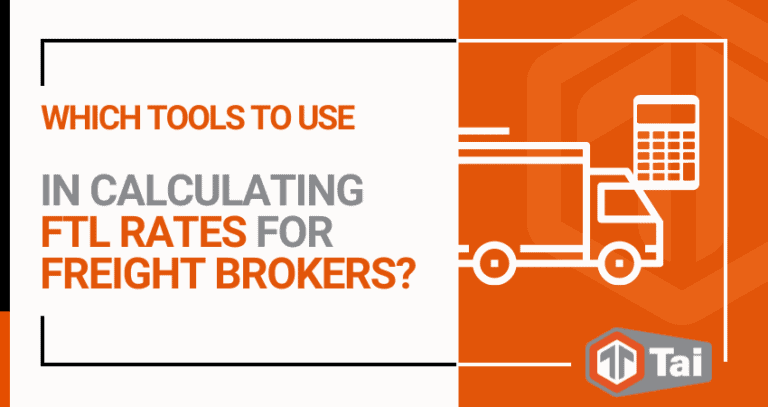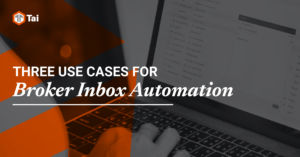Calculating FTL Rates can be a painful, manual process without the right knowledge and tools. Freight rates are constantly changing due to market fluctuations, truck capacity, mileage, and other variables. Every professional freight brokerage needs to be aware of how these factors work together and influence rate and freight shipments. The broker then needs to decide which tools best determine calculating FTL rates and freight pricing for their customers.
The first thing to know is that there are several types of truckload shipments and services, such as:
- dry van,
- refrigerated (reefer) trucks, or
- flatbed freight that are used for FTL transportation.
A full truckload (FTL) is defined by filling an entire truck trailer with a single shipment, either in volume or weight. Generally speaking, the amount of space the cargo takes up can be more important than its weight.
On average, FTL shipments range between 24 to 30 pallets. Their weight can also vary quite significantly, going from around 5,000 pounds to as much as 45,000 pounds for larger shipments. Below are some of the key factors that every broker, freight forwarder, shipper, and freight carrier should be aware of and what to use to calculate their truckload rates.
So, What Goes Into Calculating FTL Rates?
As should be expected, freight rates aren’t arbitrarily decided. Numerous variables go into each freight quote, and these rarely remain the same. Freight brokerages looking to get the next truckload’s freight rates need to understand what factors into the price fluctuations. Having this business intelligence available in real-time can be a game-changer within the trucking industry, greatly improving customer service, increasing profits and streamlining shipment processes.
- Transit Times
Expedited shipments will almost always cost more. By providing advanced notice on each load, brokers can end up saving their clients money. Shipments that are not time-sensitive can get even better pricing by making use of intermodal shipping.
- Freight Capacity
Capacity works on supply and demand. When capacity is tight, there are not enough trucks available in your area, and freight rates are expected to rise. Also known as the truck-to-load ratio, capacity is also driven by a systemic truck driver shortage and significantly influences the average rate.
- The Cost-per-Mile
According to the American Transportation Research Institute (ATRI), the average trucking cost per mile in 2019 was $1.65. That said, this rate can vary from week to week and can be influenced by market conditions, lanes, and haul distances, among others. Long-distance freight services typically start at 500 miles and usually require more time and resources than short-distance freight shipping services. Therefore, brokers can expect rates to be higher the further away the final destination is.
- Fuel Prices
To cover their fuel costs, carriers will typically include a surcharge into their rates. These fuel surcharges are based on the market price of diesel and can fluctuate on a weekly basis. As these prices rise, so will the surcharge. The US Energy Information Administration website provides current national and regional diesel fuel prices.
- Weather
Weather patterns can affect trucking rates, especially when there are snowstorms, poor visibility, and other hazards leading to closed roads or significantly delayed delivery times. Truck drivers will typically want to avoid these hassles and areas with bad weather. If freight does need to be sent to an affected area, capacity may be tight.
- High-Volume Lanes
The lane over which a particular shipment will be sent will also have an impact on how you are calculating trucking rates. High-volume lanes are routes that are regularly serviced by freight companies and that usually include major metropolitan areas. Since carriers have more dedicated trucks to these lanes, capacity is higher, and shipping costs are generally lower. The opposite is true for low-volume lanes, making shipments here more expensive to book. High-volume lanes also increase the chance of a return load for the carrier, whereas low-volume lanes increase the risk of more empty miles traveled.
- Cargo Value
The cargo’s value will also impact the rate offered by freight providers. Typically, the higher the cargo’s value, the higher the insurance requirements, and the higher the rate. There are even some carriers that don’t accept high-value loads for this exact reason.
- Truck Type
Operational fees, capacity, and market demand are all different based on each type of trucking service. Therefore, there are different freight rates for dry vans, reefers, and flatbeds. Generally speaking, both reefers and flatbeds are more expensive than dry vans since drivers require more experience to operate these vehicles.
- Lead Times
When carriers are given long lead times, it gives them more time to find a driver to transport the load. When provided with shorter lead times, capacity is tighter, and the carrier may have difficulty finding a driver. Freight brokers may be able to take advantage of their existing relationships with carriers to find reasonable rates for their clients even during tight capacity.
- Accessorial Charges
Accessorials are always a factor to consider when it comes to accurately calculating FTL rates. These represent an additional cost for extra time and services provided. Driver loading and unloading, repacking, residential delivery, appointment calls, or insurance requirements can significantly impact how much the freight costs in the end versus what the online freight quote calculator predicted.
Tools Needed For Quickly and Accurately Calculating FTL Rates 
Freight brokers can look up all of these data points manually, which could cause that broker to lose loads to the competition who might have a quicker accurately price quote. But, there are various digital tools available to make a brokerages quoting processes quicker and more accurate to what the market will bear. Broker-focused freight management software can help reduce operational costs while also giving shippers and carriers better customer service while saving them time. Generally speaking, digital tools for freight brokers are designed to reduce manual tasks and human error, provide load location visibility, automate communication, load planning, real-time rate forecasting tools, among other helpful solutions.
A good TMS, like Tai TMS, integrates with common freight broker software like:
- TruckerTools,
- DAT,
- Truckstop.com,
- FreightWaves Sonar,
- Global Logistics Solutions, dexFreight,
- FourKites,
- Quickbooks, and many more.
Below are a few tools for calculating FTL rates that every modern 3PL or freight brokerage should have:
- Transportation Management System (TMS)
A transportation management system is a tool used to make informed business decisions by putting many daily tasks under a single platform. When it comes to a TMS that focuses on brokered freight, brokers should expect to have immediate advantages over other brokers that use manual processes or older on premise solutions that were created for carriers. Some of these advantages include:- speed to quote,
- automation tools allowing your reps to cover more loads,
- less quoting errors,
- better customer service,
- freight visibility.
Some TMS’ includes hundreds of carriers and marketplaces, as well as all major transportation modes. These platforms increase visibility and business intelligence, as well as help to communicate and negotiate with carriers. An effective TMS also needs to provide reporting capabilities, metrics, invoice auditing, and other tools to help monitor performance.
Arguably the most important aspect of a robust TMS is its ability to seamlessly integrate with the existing legacy infrastructure. Any isolated systems that exist in this infrastructure limit the company’s ability to address any inefficiencies that may exist. A TMS is a platform that acts as a control tower, bringing all other digital tools under the same roof.
Tai TMS is a cloud-based transportation management software that gives brokers and their clients high visibility into every shipment. In doing so, it will increase both customer experience and minimize the risk of theft. Tai Software’s Mobile App allows for a continuous update into the self-service portal, providing on-demand visibility wherever there’s an internet connection.
Tai TMS helps brokers create loads and source coverage from your digital freight network and sort it based on carrier preferences. Load boards are directly integrated so that brokers can post loads from a single page with Tai’s automated tool.
Carrier bids also feed directly into the platform, allowing brokers to quickly onboard new carriers with their details automatically conveyed to onboarding teams. This simple workflow provides for savings and scale. It also helps to quickly and effectively determine the most efficient rates for shippers.
- Digital Freight Matching
This technology allows the freight brokerage company to discover drivers with sufficient capacity for their type of freight, the appropriate truck, and the dates and routes they require directly and instantly. Transparent and competitive rates are provided upfront, and shipments can be tracked in transit, so their whereabouts will be known at all times. Many freight brokers have started using their truck equipment pools to speed up cargo movement and increase productivity across the transportation chain.Predictive load matching uses algorithms and machine learning to determine future truck capacity. This is a potent tool as it allows brokers to see capacity in advance and book trucks before they even become available. It gives a leg up on the competition and allows for faster load coverage.
- Real-Time Visibility Software
A real-time freight visibility platform is a substantial service offering for freight brokerages. Larger shippers, especially, need permanent visibility over their shipments at stops and accurate real-time digital load tracking data on at least 70% of their loads.
- Real-Time Visibility Hardware
Some trucking companies may have specific policies enacted that prevent drivers from using app-based load tracking technology. In this situation, a freight brokerage company may have the possibility to use trucker’s ELDs for load tracking purposes.
If your Brokerage is poised for growth, we want to start a conversation with you. Our dedicated team of logistics software experts have over 20 years of freight software experience, our team is here to ensure your success. Request a free demo today and stay ahead of the curve!










